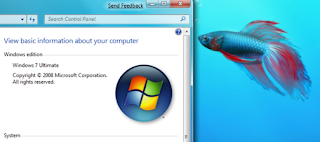Windows 8 Developer Preview Build 8102 M3 (32 & 64 Bit) ISO
Information:
Review: Microsoft demoed their upcoming Windows 8 OS during the BUILD conference on 4 Oct 2011 along with the sneak peek to developers platform
and tools. Windows 8 includes plethora of
new features
which includes the all new immersive Metro style UI, Internet Explorer
10 (IE10), Task Manager, Quick boot, Face password, Cloud integration
etc. They also made available the Windows 8 Developer Preview copy to all the attendees out there along with a
Samsung Tablet
so that the developer community can play with it and give feedback
before the RTM hits store. And for the rest of us the very same files
will be uploaded to their public servers and will be available soon.
Features:
The
main feature that was shown is the extensively redesigned user
interface, optimized for touchscreens as well as mice and keyboards. A
new "Start screen",
similar to
the one in Windows Phone 7, includes live application tiles. It replaces
the Start menu, being triggered by the Start button or Windows key, and
is also the first screen shown on startup. The user can go to the
regular desktop by choosing the "Desktop" tile or a traditional
desktop-based application. The Start screen also displays the user's
name and avatar. Windows 8 has a new developer platform according to
Microsoft Vice President Christopher Ham, who called it "our new
developer platform, which is...based on HTML5 and JavaScript. The new
applications run in full-screen, but two of them can be displayed
side-by-side using "Snap".
Examples of
new applications that were demoed include a Twitter client, a weather
application, a stock-tracking application, an RSS news feeder, and a
virtual piano.
The new interface is primarily designed for 16:9 screen resolutions, with 1366×768 and larger screens able to display two Windows 8 applications. 1024×768 screens can display one Windows 8
application in full-screen, and 1024×600 screens can only use the
traditional Windows desktop. Mike Angiulo confirmed at Computex 2011
that Windows 8 will use OEM
Activation 3.0 instead of OEM Activation 2.1 (used by Windows 7), which supposedly makes it less prone to cracks. Windows 8 features a new lock screen that shows the date and time and notifications, along with a customisable background.
Windows 8
will also include Microsoft's Hyper-V virtualization tool. Previously
only offered in Windows Server, Hyper-V will now be available in client
versions of Windows for the first time. The system requirements for
Hyper-V are a 64-bit processor, a 64-bit version of Windows 8, and a
minimum of 4 GB of RAM. Hyper-V also requires a 64-bit system that has
Second Level Address Translation (SLAT), a feature that helps with
memory management. Many of Intel's and AMD's recent processors support
this feature, including many of Intel's i-Series processors (with
Extended Page Table) and AMD's 10h family processors. On September 8,
2011, Microsoft announced that Windows 8 has short boot times, because it saves the kernel's memory to the hard disk on shutdown (similar to the existing Hibernate option) and reloads it on startup.
Cofiguration Details: All configuration same as Windows 7 (32 & 64 Bit)
Download Instructions: Click on download link to start download directly from MS own server.
Direct download with resumable option.
System Requirements-
Windows Developer Preview works great on the same hardware that powers Windows Vista and Windows 7
1 gigahertz (GHz) or faster 32-bit (x86) or 64-bit (x64) processor
1 gigabyte (GB) RAM (32-bit) or 2 GB RAM (64-bit)
16 GB available hard disk space (32-bit) or 20 GB (64-bit)
DirectX 9
graphics device with WDDM 1.0 or higher driver
Taking advantage of touch input requires a screen that supports multi-touch
To run Metro style Apps, you need a screen resolution of 1024 X 768 or greater.
Screenshots:
Download Links:































